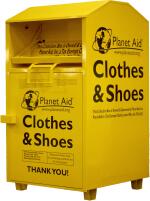Circular Economy Key Topic at WEF Annual Meeting
Last week, leaders from government, business and economics met in Davos, Switzerland for the annual the World Economic Forum (WEF).
The concept of a "circular economy" was a key topic covered at the meeting, from the opening video, which included a statement from Dame Ellen MacArthur, to the launch of the WEF's "Platform for Accelerating the Circular Economy."
"The fractures that we see are really the system in which the economy functions. What we need to move towards is a circular economy." - Dame Ellen MacArthur
Launch Platform
The Platform for Accelerating the Circular Economy (PACE) is a commitment made between 40 business and government leaders, including the Coca-Cola Company, Nigeria, the World Bank, and others, to tackle pressing environmental challenges by cutting waste and pollution from our consumption economy.
What is a Circular Economy?
Our current economy revolves around a linear model of consumption in which we use finite resources inefficiently. We manufacture, consume, and trash our products at an alarming rate. Globally, nearly 90 billion tons of materials were consumed in 2017, with only 9% cycled back into the economy.
Unfortunately, the current system is not sustainable in the long run. This type of behavior pollutes the environment, causing mass destruction to our land, seas, and the air we breathe. At the rate we're going, an estimated $4.5 trillion in "recoverable" resources will be wasted by 2030.
A circular economy is based on the idea that our production and consumption processes should operate within a "closed loop," with all resources and materials being repurposed at the end of a product's life. This concept is inspired in part by the naturally regenerative cycles found in nature. A successful circular economy would function on the foundation of balance, efficiency, and little to no waste. By shifting the focus towards optimizing resources, companies and consumers, the environment will benefit in the long run.
Just Say No to the Landfill
Achieving a circular economy requires a change in the way products are made as well as new commercial structures. Manufactured parts should be replaceable or easily detachable so that products can be repaired or repurposed instead of sent to the landfill. We would also have to consider alternatives to the one-directional output flow of our products. Leasing items instead of flat-out selling them, for example, would actually be cheaper for the consumer in many cases and prevent valuable materials from being wasted. Watch Dame Ellen McArthur, one of the biggest proponents of circular economics, explain this model using a washing machine as an example:
These concepts seem far removed from what we're used to, but there are already examples of a circular economy in motion. Philips sells lighting as a service rather than a product, ensuring smaller upfront costs and the proper management of lighting equipment. Ford Motor Company scientists are researching ways to replace petroleum oil as the main ingredient in plastic. In 2006, the company introduced the industry's first soy-based foam in seat cushions and seat backs. They have also begun using plant-based natural fibers to reinforce plastic in their vehicles.

Are We Too Lazy?
The sticking point, however, is that Americans are often a tad lazy when it comes to dealing with products at the end of their life. Research has shown that we tend to recycle only when it's convenient for us. A study in 2014 revealed that although 72 percent of consumers consistently recycle in the home, only about half do so beyond the kitchen because bins aren't readily available in other rooms.
Transforming the economy on such a large scale would require an immense effort on both the part of producers and consumers. Americans are accustomed to instant gratification; we shop on our phones, eat on the run, and yell at our computer screens if the internet connection is just slightly slower than usual. If we were to adopt circular principles, we would need to consider our habits and make sure that it's easy for us to actually complete the circle.
Getting Started
While converting our economy into a waste-free closed loop will certainly not happen overnight, we applaud leaders and the WEF in their effort to bring more attention to the current state of the environment and provide momentum for solutions, such as a circular economy, to prevent further damage in the future.

We as consumers can hasten this change by supporting companies that implement this concept. Planet Aid embraces the circular model. Our clothing collection services strive to reduce waste by making it easy for people to keep valuable resources, specifically materials from clothes and shoes, out of landfills.
To learn more about how a circular economy can help phase out negative environmental impacts from the fashion industry, read a new report released by the Ellen MacArthur Foundation, A new textiles economy: Redesigning fashion's future.
